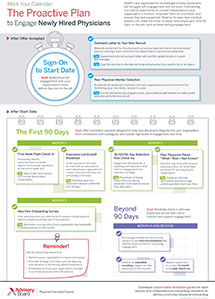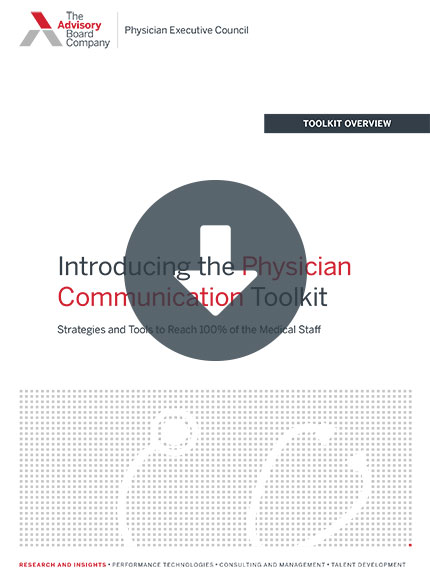Auto logout in seconds.
Continue LogoutRead Advisory Board's take: How to nudge your physicians towards better behavior
In 2016, Penn Medicine launched its so-called "nudge unit," a group focused on making it easier to implement subtle changes within a hospital to improve decision-making, and now, writing in NEJM Catalyst, Sujatha Changolkar, clinical research coordinator for the Penn nudge unit, and colleagues share how others can make nudges work at their organization.
What's in a nudge?
Health care providers will always make mistakes, the authors write, but changing the practice environment in subtle ways can help reduce the likelihood of those mistakes.
That's where nudges come in. Nudges are "subtle changes to choice architecture that can have an outsized impact on medical decision-making," Changolkar and colleagues explain. Examples of nudges in a health care environment include setting the default option of an EHR to the preferred setting or "making the advantages of particular choices more salient through … transparency or peer comparison feedback."
While changes like these might sound simple, they can be difficult to make, especially in the complicated world of health care, Changolkar and colleagues write.
That's why Penn in 2016 launched its nudge unit, which the authors believe is the world's first behavioral design team within the operations of a health system.
The nudge symposium
After launching the nudge unit, Penn wanted to exchange information about nudges with other health systems that were trying or were interested in trying something similar.
As such, Penn hosted a nudge unit symposium in September 2018 that brought together executives and researchers from 22 health systems in the United States and Canada. Through the symposiums discussions, the Penn team identified "commonly reported themes," such as "the importance of focusing first on understanding the problem, evaluating feasibility when prioritizing opportunities, engaging important stakeholders directly and indirectly related to the decisions, and coordinating planning implementation and analysis in phases … for maximal success before broader deployment," Changolkar and colleagues write.
The 5 steps to implementing nudges in health care
With these themes in mind, Changolkar and colleagues in the Catalyst piece shared five key steps to implementing nudges within a health system.
- Identify ideas that address challenges. Utilize key players—including frontline staff, clinical champions, and clinical and IT leadership—and engage patients, family members, and affected communities, Changolkar and colleagues write.
- Learn how to prioritize your ideas. Know what resources are available to your health system, understand your team's expertise, and get a good idea of the structural limitations within your health system, Changolkar and colleagues write. Clearly identify the need the nudge addresses and be aware of specific pain points. It can help to use the successes of other health systems as a guide.
- Apply the data to your problem. Gather different types of existing data from a variety of sources and use it to guide the implementation of your nudge, Changolkar and colleagues write. Explore patient behaviors and characteristics, and understand the provider burden, clinical quality measures, and practice variance of your nudge.
- Generate stakeholder support. Find support from different stakeholder groups, including nontraditional ones, such as policymakers, pharmaceutical companies, and community organizations, Changolkar and colleagues write. Align the vision of these groups and personalize ways to engage them.
- Implement elements to measure impact. Make sure you have a clear hypothesis, operationalized metrics, and outcomes that will be useful for all key players, Changolkar and colleagues write. Confirm that your pilot, implementation, and evaluation allow for both qualitative and quantitative metrics to be collected. Once you've collected data, disseminate those findings broadly, including both what worked and what didn't.
The Penn team has continued to build on nudge symposium and has since launched the Nudge Unit Collaborative. The goal of the collaborative is to create a "network of institutions focused on implementing nudges units" within health systems, as well as "a technology platform with a library of previously implemented nudges, coding guides for [EHR] implementation, and de-identified data to grow community-generated insights," the authors write (Changolkar et. al., NEJM Catalyst, 5/1).
Advisory Board's take


Jennifer Stewart, Executive Director, Taylor Hurst, Consultant, and Katherine Diller, Senior Analyst, Physician Executive Council
In October 2017, economist Richard H. Thaler was awarded the Nobel Memorial Prize for Science in Economics for his work in behavioral economics. Specifically, Thaler found that humans don't make decisions as rationally as was previously thought.
Thaler claims that as humans, we are actually consistently irrational beings who are impulsive, have strong personal preferences, and are heavily guided by emotional considerations. While this makes human behavior less predictable, Thaler's work proves that we can predict our own unpredictability and present decisions in a way that "nudges" people toward a certain choice while still retaining their autonomy.
“We're surrounded by nudges in our daily life.”
We're surrounded by nudges in our daily life. Some of them are subtle—putting the $150 dollar wine bottle at the top of the menu to make the $70 dollar bottle seem far more reasonable. Others are less discrete, such as the text alert from your bank every time you swipe your credit card for another morning coffee. Whether driving us to spend money on wine or encouraging us to save money on coffee, these nudges work because they are designed to fit seamlessly into our daily routines.
Health care isn't far behind our out-of-industry peers. In fact, from posting calories on menus to putting vending machines out of sight (and out of mind) behavioral economics can be a powerful tool to inflect health behavior.
So, what about inside the hospital? How can we leverage the power of the nudge to help our clinicians navigate the countless decisions they encounter day in and day out? It all starts with understanding where they're most likely to go off track.
“It all starts with understanding where clinicians are most likely to go off track.”
Rolling out a new care standard usually requires clinicians to change their daily behavior in a significant way. And, as hospital leaders, you've likely all come face-to-face with the change fatigue that plagues most practicing clinicians, which making it increasingly difficult to implement and sustain new initiatives.
One of the best ways to mitigate change fatigue comes to us from Texas Health Resources. Before they roll out any new standard, they use a process map to systematically anticipate critical points where clinicians are most like to "fail". They then create enablers—people, processes, or technologies—to nudge them in the right direction at each of those points. Enablers can include additional questions within an EHR order set, a sign in the break room to remind clinicians of a new protocol, or requiring sign off by a specific party. By intentionally positioning enablers at pivotal points in a new workflow, Texas Health Resources makes is easier (and more realistic) for their clinical staff to change their daily practice.
To learn how leading health systems are rolling out similar programs—and other best practices in hardwiring sustainable practice change across your organization—download our report on Ten Insights on Reducing Care Variation from Leading Health Systems.
Make sure you're communicating effectively with physicians
Our physician communication toolkit offers benchmarks, templates, tips, and step-by-step guides to help physician executives and communication staff save time and avoid common pitfalls when implementing new communication strategies.
Download the toolkit overview to get high-level strategies and a glimpse of the resources inside the toolkit. Then, explore the toolkit resources below.
Don't miss out on the latest Advisory Board insights
Create your free account to access 1 resource, including the latest research and webinars.
Want access without creating an account?
You have 1 free members-only resource remaining this month.
1 free members-only resources remaining
1 free members-only resources remaining
You've reached your limit of free insights
Become a member to access all of Advisory Board's resources, events, and experts
Never miss out on the latest innovative health care content tailored to you.
Benefits include:
You've reached your limit of free insights
Become a member to access all of Advisory Board's resources, events, and experts
Never miss out on the latest innovative health care content tailored to you.
Benefits include:
This content is available through your Curated Research partnership with Advisory Board. Click on ‘view this resource’ to read the full piece
Email ask@advisory.com to learn more
Click on ‘Become a Member’ to learn about the benefits of a Full-Access partnership with Advisory Board
Never miss out on the latest innovative health care content tailored to you.
Benefits Include:
This is for members only. Learn more.
Click on ‘Become a Member’ to learn about the benefits of a Full-Access partnership with Advisory Board
Never miss out on the latest innovative health care content tailored to you.


